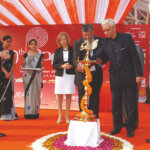“When paper is manufactured at paper machine then it is cut in desired shape and weight. Reel is cut on the rewinder and sheets are cut on sheet cutter. After checking the quality of paper it is packed according to demand of consumer.”

Reading the above lines seems that finishing is a very simple task. But that’s not true it is a very important and a critical exercise because that determines the result of your hard work. Being the last exercise in the paper manufacturing it demand extra focus, attention, detailing and every possible step to make it a success. A small haywire will bring down the value of your investments. During the interaction with team Paper Mart, we asked Mr. Renato Duranti, Director – Sales, Milltex S.p.A., a renowned supplier of machineries for finishing houses to highlight the importance of finishing house and how paper mills in India can benefit by installing good machineries at their finishing house along with the challenges that are being faced today.
Paper Mart: Finishing section is one area, which seems to be neglected in many Indian paper mills. Your views on this current situation
Renato Duranti: In the present market situation nobody can neglect the finishing house, as competition is very tough in terms of quality and timely delivery of the material and tailor sizes. Market will not accept any size variation, rough cutting, marking, uneven dressing etc. To achieve all these quality parameters finishing house needs to invest in machineries with high precision technology. Even for reel order the quality of the cut, winding, length of the reel also plays very important role. If there is unevenness in the reel then there will be issues in running the reel on the printing machine, so investment in good quality rewinder is also important. Presently demand of copier paper is rising so a good quality sheeter and packaging line plays an important role. Other than all the above quality parameters finishing house machineries in terms of production is also very important to cope up with the market demand and to handle huge production coming from the paper machine. We must always keep in mind that the printing industry is running much ahead as compared to the paper industry all over the world in terms of adapting automation, increasing printing speeds and quality requirements. Hence paper industry has to be watchful and aggressive to adapt to challenges ahead and make their investments accordingly. I was very surprised to hear from one of the Indian premium board company, who told that the 70% of the quality complaints that they used to receive were due to the finishing house. So it says of its importance!
PM: What action plan you would suggest to the Indian mills irrespective of their size & scale and product manufactured?
RD: Before finalizing the machineries for finishing house first and foremost thing is to properly design the layout for finishing house, because without this there are chances of jamming and chaos at finishing house for which may be sometimes paper machine has to stop. After that, finalization of the machineries is required as per the parameters mentioned above. In India generally the manufacturers face the severe crises of small order quantities. So a major decision must be taken in light of this challenge that only small sheeters may be bought or not? The usual sizes which industry buys are 2.8, 2.4, 2.2, 1.9 meters. It would be good idea to buy more number of small sheeters rather than buying one large sheeter.

PM: ROI is the first question before finalizing a technology/equipment. Kindly justify the value on investment in the finishing section for the Indian mills.
RD: Earlier paper machine were running either with machineries taken from local manufacturer or second hand machineries from aboard. But, looking into present market scenario, to achieve quality parameters and precision machineries with high speed is important. Presently production from high speed machine is 3-4 times higher than the low speed machine. So, there will be 3-4 times less manpower requirement and power consumption than earlier machineries. So when paper mill will calculate the ROI in terms of power saving, premium for quality product, access to export market and manpower saving then automatically they will understand that investment in high technology machineries are worth it.


